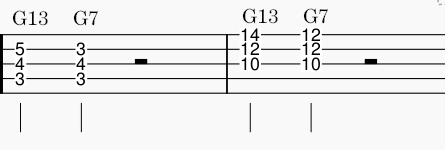9 and 13th chords for Banjo: Part Two
Today we continue into how to play 13th chords on the 5-string banjo. This is part two from my prior blog post on how to play 9 chords on the banjo.
13 chords are probably one of the most elaborate chords you will use. These are really useful for expanding on chords within jazz tunes and writing your own songs. You’ll even find them in later classical music.
How do we play a 13th chord?
Let’s take our G major scale again:
G A B C D E F# | G A B C D E F#
Take a G9 chord formed from this (which you learned previously), and add two more notes.
So, G B D F A are the notes in a G9 chord……and continue skipping every other note further
The complete sequence is G B D F A C E (1-3-5-b7-9-11-13).
Yes, this is a chord with SEVEN notes. However, don’t panic yet. Just like with the 9 chord, we are in luck. We don’t have to play all of these notes. What two notes must we conclude? Our ESSENTIAL 3rd and b7th. Then of course we need this new note, the 13th. In short, all we need is the 3rd, b7th, and 13th for it to sound “right.”
13th chord fingerings for Banjo
Here I show how to go from the 13th chord down to the regular 7th chord (a common progression)

The notes you are playing are F-B-E, no root, no 11, no 9, and no 5th (3rd, b7th, 13th). You’ve reduced the seven note version down to three notes. This is okay because you have the 7th in there and the 3rd. In addition, the 13th is pitched above the 7th, so it will sound like a 13th chord when played. This is not always possible; however, when possible, you want to keep the 13th up in the higher registers. After all….that’s why it’s called a 13th numerically.
Even jazz pianist do these three note voicings, despite the fact they have more fingers available for all of the notes. When you try to play a seven note chord, you’ll hear it sounds kind of like MUSH and not very clear. There are too many notes for your ears to distinguish everything. When I play this chord on the guitar, I usually add the root back in if I can, or the 9th sometimes.
For the first voicing above, you could add the root back in, but it will be higher than the 13th (Try adding the 5th fret, 1st string with your pinky to the voicing).
Both of these chords are moveable voicings. If you want to play an A13, simply move them up two frets.
If you’d like even more details on these types of chords, I recently did a workshop on these chords (as well as all the majors and minor extensions)….The workshop and worksheets are available to my PATREON members
Please consider signing up for my email newsletter to get notified when I update the website and post new products.


